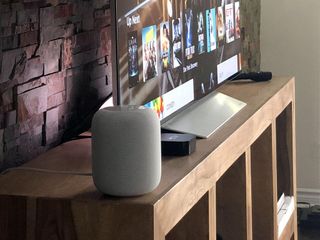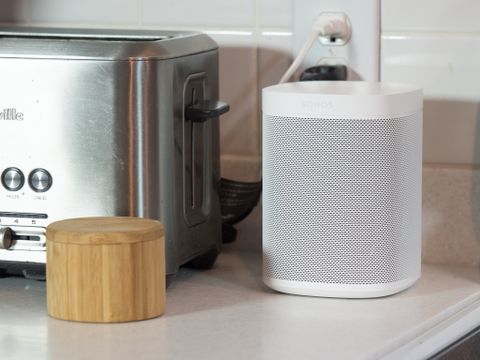
Tiny Power
While it doesn't sound quite as good as the HomePod and doesn't fill a room in the same way, the Sonos One is an excellent speaker, and great in a wireless stereo pair. It's cheaper than the HomePod by $150 and has Alexa integration built in, even if it's only available in a handful of countries. Thanks to AirPlay 2, the Sonos One is also compatible with Siri through your iPhone or iPad and can play audio as part of a whole-home sound system with other AirPlay 2 speakers.
For
- Excellent sound
- Less expensive than the HomePod
- Supports Alexa for music playback and home automation
- AirPlay 2 support
- Can stereo pair with another Sonos One
Against
- Sound only plays in one direction
- Sound doesn't fill a room like HomePod
- Alexa only available in a handful of regions

Superior sound
Apple set out to create a great speaker with the HomePod, and that's exactly what they did, with this small speaker producing great sound far above its weight class. An AirPlay 2 speaker, HomePod can stereo pair with another HomePod for even better sound from both. Having Siri built in means you can play music using just your voice like you can with the Sonos One, but native music support is limited to Apple Music, at least for now. It's main drawbacks are its price compared to the Sonos One, issues that continue to plague Siri, and limited native integrations.
For
- Superb, massive sound
- AirPlay 2
- Can stereo pair to another HomePod
- Siri built-in
- Great for Apple Music subscribers
- Works great with HomeKit
Against
- More expensive than the Sonos One
- Siri still has its struggles
- Not natively integrated with music services other than Apple Music
If you're subscribed to Apple Music and are looking for a speaker with built-in voice assistant support for it, get a HomePod, you'll love it. But if you're looking for something that can work with most music services (including Apple Music), features a versatile voice assistant, and still sounds great, the Sonos One is for you.
The big differences
Between the Sonos One and the HomePod, the biggest factors for most people are sound quality and price. There are virtual assistant capabilities to consider, but we'll focus on sound quality and price primarily as both products seem to be designed as speakers first, and assistants-in-cans second.
Looking at sound quality alone, I'd have to pick the HomePod. Computational audio does a lot of excellent work to get that tiny speaker to fill a room, and the sound the HomePod produces is outstanding. Yes, only Apple Music support is built in right now, but with AirPlay 2, that's not as big of a hurdle as it would have been even a year ago.
But then there's the other major factor: price. For the sound quality you get, it's hard to beat the Sonos One at that price. At $199, it's $150 cheaper than the HomePod. Does the HomePod sound $150 better? That depends on the person. As someone who owns a HomePod, it sounds wonderful. While the Sonos One doesn't sound quite as good, but it still sounds great, and it's probably good enough for most people.
| Header Cell - Column 0 | Sonos One | Apple HomePod |
|---|---|---|
| Size | 4.8" x 4.8" x 6.4" | 5.6" x 5.6" x 6.8" |
| Weight | 65oz | 88oz |
| Voice control | Yes | Yes |
| Virtual Assistant | Alexa | Siri |
| Multiroom audio | Yes (Sonos, AirPlay 2) | Yes (AirPlay 2) |
| Bluetooth | No | Yes (not for music playback) |
| Smart home control | Yes | Yes (HomeKit) |
| Line out | No | No |

If we look at the virtual assistants packed into these speakers — Alexa for Sonos One and Siri for HomePod — some important differences manifest themselves. Both assistants have similar base capabilities, answering questions about the weather, setting timers, letting you set reminders and calendar events, and more. Both also allow you to control various smart home devices with your voice. However, Alexa has thousands of skills available from developers all over the world, turning it into an assistant capable of so much more than Siri on the HomePod. Because though Siri for iPhone and iPad has seen its abilities expand exponentially with the launch of Shortcuts, those Shortcuts don't run natively on Siri on the HomePod, but instead, run on your iPhone if you trigger them using your HomePod.
While Siri is a great Apple Music assistant, music is where another advantage of Sonos One comes to light. In addition to Amazon Music, you can set up other music services with Alexa, including Spotify, Tidal, and Deezer (Apple Music also recently came to Alexa, but it's restricted to Echo devices for now). So in addition to whatever streaming service you already have linked to Sonos, you can command others using Alexa. This is something that Siri can't do just yet. Hopefully, Apple will add this capability one day, but for right now, because of this limitation, the Sonos One is the best pick for use with most music services.
The bottom line is this: the HomePod is great for Apple Music subscribers, and I highly recommend it. It's the better-sounding of the two speakers. That being said, most people should get the Sonos One right now. It has the more capable assistant and natively supports more music services.
The HomePod beats the Sonos One when it comes to sound, but the Sonos One still sounds great and is much less expensive than the HomePod. Most people should probably get the Sonos One. Getting a bundle of two, which you can then stereo pair, actually only costs about $30 more than getting one HomePod. However, if you're already all-in on Apple products, you might still want to consider a HomePod. It really does sound amazing.

The small speaker most people should get
While its sound isn't a full as the HomePod, this small speaker still packs a punch at a much lower price. Built-in Alexa support lets you control Spotify with your voice, and AirPlay 2 lets it you control it with Siri.

A great speaker for Apple fans
Packing power sound in a small form factor, the HomePod delivers astounding sound quality for Apple Music subscribers. It's hampered by a lack of integration with third-party music services, though AirPlay does help alleviate some of those issues.
Joseph Keller is the former Editor in Chief of iMore. An Apple user for almost 20 years, he spends his time learning the ins and outs of iOS and macOS, always finding ways of getting the most out of his iPhone, iPad, Apple Watch, and Mac.


